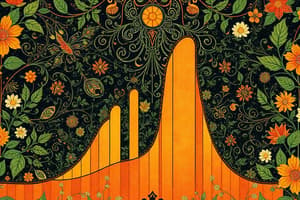Podcast
Questions and Answers
What is the formula for variance?
What is the formula for variance?
- $\sigma^2 = (x_i - \bar{x})^2$
- $\sigma^2 = \frac{\sum_{i=1}^{n} x_i}{n}$
- $\sigma^2 = \sum_{i=1}^{n} (x_i - \bar{x})$
- $\sigma^2 = \frac{\sum_{i=1}^{n} (x_i - \bar{x})^2}{n}$ (correct)
What is the main purpose of calculating variance?
What is the main purpose of calculating variance?
- To measure the spread of data around the mean (correct)
- To find the median of the data
- To find the mean of the data
- To identify outliers in the data
What is the unit of standard deviation?
What is the unit of standard deviation?
- Squared units
- Different units
- The same units as the original data (correct)
- No units
What does a small standard deviation indicate?
What does a small standard deviation indicate?
What is the formula for standard deviation?
What is the formula for standard deviation?
What is the sixth step in calculating variance and standard deviation?
What is the sixth step in calculating variance and standard deviation?
What does a large standard deviation indicate?
What does a large standard deviation indicate?
Why is variance always non-negative?
Why is variance always non-negative?
What is the main purpose of calculating the variance of a data set?
What is the main purpose of calculating the variance of a data set?
Which of the following statements about the variance is true?
Which of the following statements about the variance is true?
What is the relationship between the standard deviation and the variance of a data set?
What is the relationship between the standard deviation and the variance of a data set?
What is the purpose of calculating the standard deviation of a data set?
What is the purpose of calculating the standard deviation of a data set?
Which of the following statements about the standard deviation is true?
Which of the following statements about the standard deviation is true?
What is the correct sequence of steps to calculate the variance and standard deviation of a data set?
What is the correct sequence of steps to calculate the variance and standard deviation of a data set?
What does a large standard deviation indicate about the data?
What does a large standard deviation indicate about the data?
What is the main difference between the variance and the standard deviation?
What is the main difference between the variance and the standard deviation?
Which of the following is a reason why the variance of a data set is not directly comparable with the mean or the data themselves?
Which of the following is a reason why the variance of a data set is not directly comparable with the mean or the data themselves?
What does a small standard deviation indicate about the data points?
What does a small standard deviation indicate about the data points?
What is the purpose of calculating the variance of a data set?
What is the purpose of calculating the variance of a data set?
Which of the following is a property of standard deviation?
Which of the following is a property of standard deviation?
What is the result of dividing the sum of the squared deviations by the number of data points?
What is the result of dividing the sum of the squared deviations by the number of data points?
What is the purpose of calculating the squared deviations?
What is the purpose of calculating the squared deviations?
Which of the following is a step in calculating the variance and standard deviation?
Which of the following is a step in calculating the variance and standard deviation?
What is the relationship between the standard deviation and the variance of a data set?
What is the relationship between the standard deviation and the variance of a data set?
What is the main difference between the variance and standard deviation of a data set?
What is the main difference between the variance and standard deviation of a data set?
What is the effect of squaring each deviation from the mean on the variance?
What is the effect of squaring each deviation from the mean on the variance?
What is the implication of having a large standard deviation on the interpretation of the data?
What is the implication of having a large standard deviation on the interpretation of the data?
What is the purpose of calculating the variance of a data set?
What is the purpose of calculating the variance of a data set?
What happens to the variance when the data points are multiplied by a constant?
What happens to the variance when the data points are multiplied by a constant?
What is the relationship between the variance and standard deviation of a data set?
What is the relationship between the variance and standard deviation of a data set?
What is the effect of having a small standard deviation on the interpretation of the data?
What is the effect of having a small standard deviation on the interpretation of the data?
Why is the variance of a data set always non-negative?
Why is the variance of a data set always non-negative?



